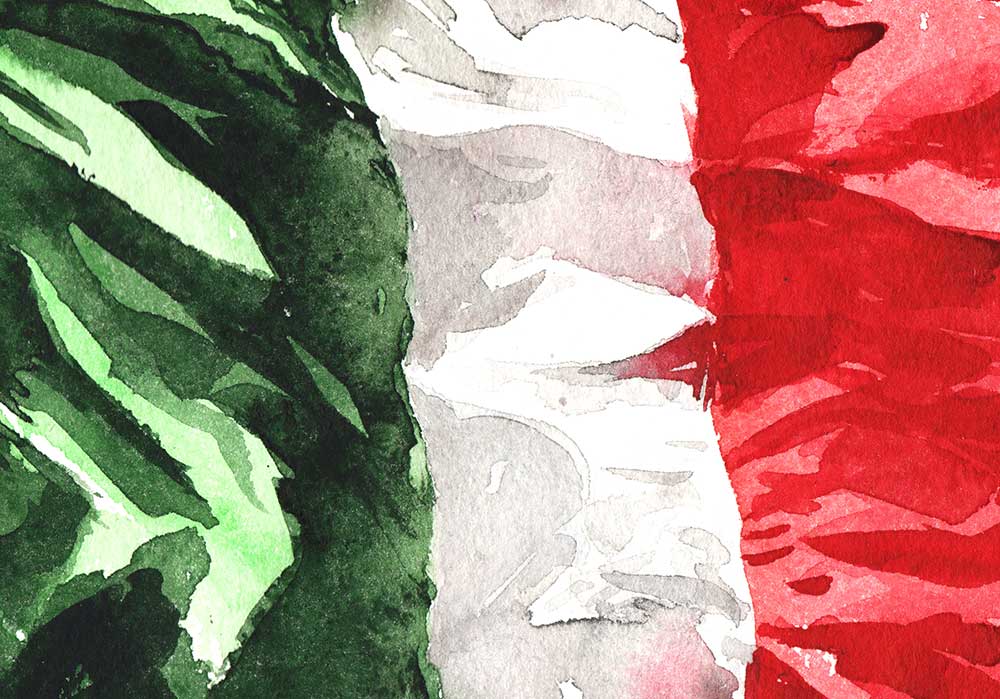If there is a symbol every Italian identifies with, that’s the Tricolore. A synonym of national unity and of the many battles we fought to get the Belpaese we love. A reminder of the tragic sea of people who died for the very ideals which, today, characterize and inspire our society, it has also, on more than one occasion, invited the people of Italy to feel like one in their shared history, and to recognize themselves with strength in the symbols of the Republic.
“The bandiera tricolore must be present in our homes and kept with care. It is a living, contemporary symbol, the modern emblem of an ancient people of great culture, traditions, art, nobility of spirit. It should be given as a gift by mayors – who all wear a tricolored sash – to newly-weds and every new Italian citizen.” In recent times, the 10th president of the Republic, Carlo Azeglio Ciampi (1999-2006), often highlighted the importance of national symbols and rituals: he celebrated the sacrality of the flag, often concluding his speeches with a passionate “Long live the Tricolor, long live our Flag, long live Italy.” He, more than others, tried to rouse in his people a non-rhetorical sense of belonging to the Nation, and bring the idea of Fatherland back to the fore because he had understood the importance of unity, of a common sentiment of belonging, of shared values rooted in our history: a common thread joining together Risorgimento, Resistenza, our Constitution and Republican ideals.
But Ciampi also tried to develop in each Italian citizen a deep and personal connection with these symbols, so that they weren’t only empty vessels; so that the military parades and the Fori Imperiali could become a moment of union and gratitude for the service given both within and without our national borders, and not only a showing off of aggressiveness or power; so that the concerts and parties at the Quirinale gardens weren’t just a runway for VIPs, but a collective celebration of our Fatherland’s unity and its citizens’ freedom, just like it’s written on the Vittoriano.
This is why, during the last speech of his presidency, Ciampi said: “Since the very first day, I lived at the Quirinale with my wife: it’s been my home for seven years, the President of the Republic’s home, the Italian people’s home.” For the same reasons, the Palazzo del Quirinale (with its Napoleonic apartments, the Studio della Vetrata and the Lille tapestries room), a concentrate of 400 years of history and art, has been open to the public ever since, it has been given back to people, to citizens, so that it can be visited and loved. So that it is no longer a vestige of power, but of Italian culture.
A seed that has developed well if, in the darkest of times, at the beginning of the pandemic, Italians spontaneously took the tricolor out of their drawers and hang it at their windows to give each other strength. And those who didn’t have a flag at home got creative and made one with towels, sweaters, and paper colored in green, white, and red.
“The warmth with which many of my fellow citizens, in the most difficult of times, displayed our flag at their windows and sang the Canto degli Italiani, marked our country’s collective memory, bringing back the fundamental values of solidarity and social cohesion. All institutions and all expressions of civic society did their part.” These are the words Sergio Mattarella, he himself about to leave the Quirinale, in a message to the country which has certainly been a goodbye, but also a thank you to Italy and her people “for their maturity and for the sense of responsibility they demonstrated” in their choice of “not wasting the opportunity to get vaccinated,” as well as an invitation to have faith and to solidarity. Mattarella, whose popularity has progressively grown through the years and has become particularly strong during the pandemic, spoke to people and not to the palazzo, that is, to the parties that are fighting over who’ll be his successor. When speaking to “the mayors and their communities, to the Region Presidents and to all those who relentlessly worked on the territory, with people,” that is, to the local symbols of our Tricolore, he said he recognized “the true face of a unified and fraternal Republic. Patriotism concretely expressed in the life of the Republic.”
He invited the community to “look forward, aware that the destiny of Italy depends on every one of us, too.” He expressed hope, even though the pandemic “inflicted deep social, economic and moral wounds,” and that “the journey is going to be long and difficult still.” But, as we have “the resources to strike back and rebuild,” we can start again. He, then, appealed to be aware, to pursue “the Italian people’s common aspiration to be a true community,” just like our flag asks us to do. “Often, especially in recent times, we stressed how we can overcome difficulties only if every single one of us accepts to do our part. If I look at the journey we have taken together in the past seven years – he concluded – I am hopeful. Italy will grow. Even more so when it’ll recognize the common destiny of our nation, and all European nations. Happy new year to you all! And happy new year to our Italy!”.
Se c’è un simbolo in cui un italiano si riconosce è il Tricolore. Sinonimo dell’unità nazionale e delle tante lotte che sono state necessarie per arrivare al Belpaese che abbiamo oggi, monito e onore della tragica montagna di persone morte per conquistare gli ideali che oggi ispirano e permeano la nostra società, ha più volte chiamato gli italiani a sentire l’appartenenza ad una storia comune e a riconoscersi con convinzione nei simboli della Repubblica.
“La bandiera tricolore va esposta nelle nostre case e tenuta con cura. È un simbolo vivo e attuale, emblema moderno di un popolo antico, ricco di cultura, di tradizioni, di arte e di nobiltà d’animo che dovrebbe essere donato dai sindaci che indossano la fascia tricolore alle coppie di sposi e a ogni nuovo cittadino italiano”. In tempi recenti, si deve al 10° presidente della Repubblica Carlo Azeglio Ciampi (1999 – 2006) il rilancio del senso della patria attraverso le sue rappresentazioni e i suoi rituali: ha più volte esaltato la sacralità della bandiera, concludendo spesso i suoi discorsi con un convinto “Viva il Tricolore, viva la nostra Bandiera, viva l’Italia”. Più di altri ha cercato di suscitare negli italiani un non retorico senso di appartenenza alla Nazione, un convinto recupero dell’idea di Patria percependo l’importanza del senso di unità, di un comune sentire, di appartenenza valoriale a quella storia che unisce con un filo rosso Risorgimento, Resistenza, Costituzione e ideali della Repubblica.
Ma ha cercato di istillare un senso comune e capillare, un legame personale con questi simboli perché non fossero vuoti rituali, perché le parate militari ai Fori fossero un momento di incontro e gratitudine al servizio reso dentro e fuori i confini nazionali e non un’esibizione di forza o aggressività, perché le feste e i concerti nei Giardini del Quirinale fossero non una sfilata di vip ma una celebrazione collettiva dell’unità della patria e della libertà dei cittadini, come recita il marmo del Vittoriano, a ricordo degli ideali che hanno fatto l’Italia.
Per questo, in occasione dell’ultimo discorso del suo settennato, Ciampi disse: “Ho voluto abitare, con mia moglie, sin dal primo giorno, nel Quirinale: da sette anni è la mia casa, la casa del presidente della Repubblica, la casa degli italiani”. Per le stesse ragioni, da allora il Palazzo del Quirinale (al suo interno scintillano fra gli altri gli Appartamenti napoleonici, lo Studio alla Vetrata, la Sala degli Arazzi di Lille), un condensato di 400 anni di storia e di arte, è stato aperto al pubblico, restituito alla gente, ai cittadini come luogo da visitare e conoscere perché non sia più un simbolo di potere ma un luogo di cultura italiana.
Un seme che evidentemente ha dato frutti se, proprio nel momento più buio, allo scoppio della pandemia, spontaneamente gli italiani hanno tirato fuori il Tricolore che avevano in casa e lo hanno appeso alle finestre per farsi reciprocamente coraggio, e chi non lo aveva si è ingegnato per riprodurlo con asciugamani, maglioni o fogli colorati di verde, bianco e rosso.
“Il calore con cui tanti concittadini, nei momenti più difficili, hanno esposto la bandiera alle finestre di casa e intonato il Canto degli Italiani, ha segnato la memoria collettiva del Paese e richiamato il valore fondamentale della solidarietà e della coesione sociale. Tutte le istituzioni e le espressioni della società civile hanno saputo compiere la loro parte”. Così ha detto Sergio Mattarella che si appresta a sua volta a lasciare il Quirinale, non prima di un discorso al Paese che è stato sì di congedo ma anche di ringraziamento all’Italia e agli italiani, “per la maturità e per il senso di responsabilità dimostrati” nella scelta di “non sprecare l’opportunità di vaccinarsi”, di invito alla fiducia e alla speranza ma anche alla solidarietà.
Mattarella, la cui popolarità è progressivamente cresciuta negli anni e si è rafforzata soprattutto durante la pandemia, ha parlato alla gente e non al palazzo ovvero ai partiti che si contendono il successore. Rivolgendosi “ai sindaci e alle loro comunità, ai presidenti di Regione, a quanti hanno incessantemente lavorato nei territori, accanto alle persone”, ovvero ai simboli locali del Tricolore, ha detto di aver riconosciuto “il volto reale di una Repubblica unita e solidale. E’ il patriottismo concretamente espresso nella vita della Repubblica”.
Ha invitato tutti a “guardare avanti, sapendo che il destino dell’Italia dipende anche da ciascuno di noi”. Ha espresso speranza nonostante la pandemia “che ha inferto ferite profonde: sociali, economiche, morali. Sarà – ha detto – un cammino ancora lungo e non privo di difficoltà”. Ma poichè abbiamo “le risorse per reagire, per ricostruire” potremo ripartire. Così ha rivolto un appello alla consapevolezza, a coltivare “l’aspirazione diffusa degli italiani a essere una vera comunità”, proprio come chiede di fare la bandiera italiana. “Tante volte, soprattutto negli ultimi tempi, abbiamo sottolineato che dalle difficoltà si esce soltanto se ognuno accetta di fare fino in fondo la parte propria. Se guardo al cammino che abbiamo fatto insieme in questi sette anni – ha concluso – nutro fiducia. L’Italia crescerà. E lo farà quanto più avrà coscienza del comune destino del nostro popolo, e dei popoli europei. Buon anno a tutti voi! E alla nostra Italia!”.































